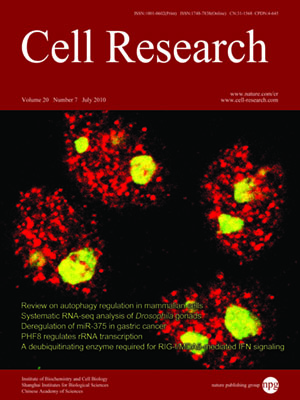
Volume 20, No 7, Jul 2010
ISSN: 1001-0602
EISSN: 1748-7838 2018
impact factor 17.848*
(Clarivate Analytics, 2019)
Volume 20 Issue 7, July 2010: 748-762
REVIEWS
Overview of macroautophagy regulation in mammalian cells
Maryam Mehrpour1,2, Audrey Esclatine1,2, Isabelle Beau1,2 and Patrice Codogno1,2
1INSERM U756
2Universit?Paris-Sud 11, Facult?de Pharmacie, 5 rue Jean-Baptiste Cl閙ent 92290 Ch鈚enay-Malabry, France
Correspondence: Patrice Codogno,(patrice.codogno@u-psud.fr)
Macroautophagy is a multistep, vacuolar, degradation pathway terminating in the lysosomal compartment, and it is of fundamental importance in tissue homeostasis. In this review, we consider macroautophagy in the light of recent advances in our understanding of the formation of autophagosomes, which are double-membrane-bound vacuoles that sequester cytoplasmic cargos and deliver them to lysosomes. In most cases, this final step is preceded by a maturation step during which autophagosomes interact with the endocytic pathway. The discovery of AuTophaGy-related genes has greatly increased our knowledge about the mechanism responsible for autophagosome formation, and there has also been progress in the understanding of molecular aspects of autophagosome maturation. Finally, the regulation of autophagy is now better understood because of the discovery that the activity of Atg complexes is targeted by protein kinases, and owing to the importance of nuclear regulation via transcription factors in regulating the expression of autophagy genes.
Cell Research (2010) 20:748-762. doi: 10.1038/cr.2010.82; published online 15 June 2010
FULL TEXT | PDF
Browse 2361


